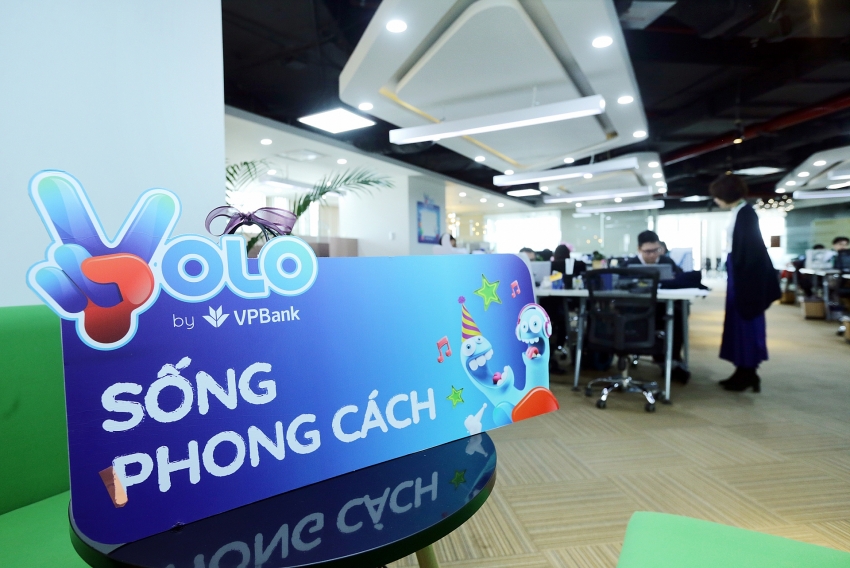VPBank seeks digitisation for cost reduction and profit maximisation
 |
| Digitisation helped VPBank reduce CIR from 35.5 per cent in 2017 to 34.3 per cent in 2018 |
Fuel for life
Hanoi-based VPBank has been known to invest rather seriously in advanced technologies, innovative banking solutions, and eventually a digital bank last year. Its subsidiary, FE Credit, also devoted ample resources to disruptive technologies for an extreme makeover of its entire operations, from front to back office.
Last summer, VPBank launched its Dream app assisting its customers in managing their personal finance via the convenience of their smartphone. During fall, it introduced the one-of-a-kind digital bank called Yolo that embeds an incorporated ecosystem of financial services and facilities like dining, entertainment, transportation, and so on. FE Credit, similarly, introduced its automated lending platform called $Nap in 2018, together with SHIELD (an app to purchase insurance online) and FE Card Mobile (a virtual credit card for FE’s credit card users), all aimed for a seamless and simplified lending experience for customers.
According to VPBank’s unaudited financial results released in mid-January, on a consolidated basis, total operating income (TOI) rose by 24 per cent on-year to VND31.061 trillion ($1.35 billion), which was offset by a 20 per cent increase or VND10.634 trillion ($462.35 million) in total operating expenses.
Whilst the bigger share of the operating costs arrived from salaries and other related expenses, which remained steady at 57 per cent of the total for both 2017 and 2018, 17 per cent of the cost bundle arose from technology investment alone, a drop of 3 per cent compared to 2017. Such tech cost was said to match VPBank’s new businesses that led by digitisation and automation.
On a single basis, VPBank’s cost of acquiring income or cost to income ratio (CIR) for 2018 settled at 40.9 per cent, following the 44.6 per cent reported in 2017 and the 44.1 per cent in 2016. FE Credit noted its CIR dropping from the 34.2 per cent in 2016 to 27.3 per cent in 2017, before edging up a bit to 28 per cent last year.
For the group as a whole, CIR sat at 34.2 per cent for 2018, a lower ratio compared to 2017’s 35.5 per cent and 2016’s 39.3 per cent.
As a rule of thumb, the lower the CIR, the more efficiently the bank and its subsidiaries operate. The sliding CIR on the consolidated basis, in this case, has signalled an early payoff for all.
As per EY’s Banking in Asia-Pacific report released some years ago, average CIR at banks across emerging APAC countries, including Vietnam, mounted up around 45 per cent in 2014, with technology spending out of the cost bundle to increase by some 5.6 per cent in 2015 and relatively the same in 2017.
EY noted then that amid the slowing growth of emerging markets, real transformation will be required to get costs back under control and to ensure there is sufficient scope to invest in new technology and not cede more ground to new entrants. “In response, banks across APAC are starting to invest more in technology to both drive efficiency, through simplification and standardisation, and maximise growth opportunities,” the report wrote.
 |
| E-bank YOLO has lured in 200,000 users in only three months |
Early results
Luu Thi Thao, VPBank standing deputy CEO, noted that the tech-led investment has started to deliver sound results to the bank and its subsidiary “as it provides an opportunity to optimise their costs and allow them to control their costs in a more efficient manner.”
“The automated products and services have helped us retain our customers and the technology investment has opened up new streams of revenue for us, while adding more value for the bank in not only 2018, but also in the years to come,” said Thao at a recent meeting held at VBBank’s headquarters in late January.
Online transactions at the bank, for instance, as Thao singled out, accounted for up to 55 per cent of its total transactions in 2018. A brief glance at the digital journeys of VPBank also disclosed the digital contribution to total retail banking cards at 32 per cent and digital contribution to total unsecured personal loans (UPL) disbursed loans at 35 per cent.
For FE Credit, in particular, following the $Nap pilot campaign running from August to November, its loan applications and volume soared significantly by 280 per cent a month on average. Its loan disbursal during the last quarter of 2018 also went up by 50 per cent quarter-on-quarter.
When it comes to managing the cost of technology investment, FE Credit vice chairman and CEO Kalidas Ghose shared that it was kept “reasonably small,” totalling at less than 0.1 per cent of the company’s revenue and 0.3 per cent of its profits last year.
Ghose noted that he and his team has spent time and effort to design their innovative solutions, make the technologies available on a collaborative term rather than building them in-house and then decide to use them in the most cost-effective way. “As a result, we have actually been able to conduct or execute this digital transformation on a fairly economic basis.”
Changing gear in the fast lane
Enduring in a banking market that has started to stabilise alongside a variety of rivals in Vietnam would require local banks to embrace more than just proper tactics but a long-term vision. Going digital, investing in quality or obtaining new customer segments are a few approaches to name, and they have in fact been equally well adopted by VPBank during the course of 2018, in a bid to keep ahead of competition and to prepare for growth in a sustainable manner.
VPBank CEO Nguyen Duc Vinh, when remarking on the lender’s financial results in 2018, referred to its performance as being slower but rather leaner thanks to its focus on technology investment to enhance customer experience and the cleaning up of certain customer segments that did not generate profit, while onboarding those that have future growth potential.
VPBank, in particular, initiated its affluent banking brand VPBank Diamond to take advantage of the rising middle-income bracket in Vietnam by offering them wealth management products and tailor-made solutions that fit their specific demands. The affluent customer base, as per the bank’s account, increased five-fold over the course of January to December last year, contributing some 75 per cent of the bank’s total deposits, 50 per cent to insurance sales, and 100 per cent in investment products sales.
For both VPBank and FE Credit, opting for digital investment seems to be the right path as the increased business volumes now start to offset the high upfront investment cost, with CIR being improved over time and consolidated return on equity (ROE), return on assets (ROA), and net interest margin (NIM) to land at 22.8, 2.5, and 9 per cent, respectively.
Vinh of VPBank said that despite missing its profit target set for 2018, the bank was able to optimise all of its new revenue streams while managing to keep costs down, to subsequently maximise its profit and secure itself in the top four banks in terms of profit in Vietnam.
“Although we did not fulfil our goal due to internal matters, what we have rolled out in 2018 will act as a basis for our development in 2019,” said Vinh.
Indeed, with at least the digital platform created at both the bank and its consumer finance arm, what comes out on the horizon will possibly be lower branch network costs that lead to the bank’s affordability to offer higher interest rates to attract deposits and long-term cost reduction as automation can now replace human resources, making room for profit maximisation.
What the stars mean:
★ Poor ★ ★ Promising ★★★ Good ★★★★ Very good ★★★★★ Exceptional
 Tag:
Tag:
Related Contents
Latest News
More News
- Tax sector wraps up 2025 and sets priorities for next year (December 25, 2025 | 14:00)
- A tipping point for digital and hybrid wealth management in Vietnam (December 23, 2025 | 13:33)
- $250 million deal targets women-owned SMEs, sustainable agriculture (December 22, 2025 | 17:40)
- Stock market posts resilient 2025 performance (December 19, 2025 | 18:17)
- Citi Vietnam receives 2025 AmCham CSR recognition (December 19, 2025 | 16:35)
- As global green supply chain reshapes, will Vietnam be left behind? (December 19, 2025 | 08:00)
- Banks gear up for massive capital increases (December 18, 2025 | 17:04)
- Securing capital and efficiency for Vietnam’s 2026-2030 growth ambitions (December 17, 2025 | 10:00)
- Energy sector in need of blended finance mechanisms (December 17, 2025 | 09:00)
- Vietnam still has room to mobilise capital for sustainable growth (December 17, 2025 | 08:57)



























 Mobile Version
Mobile Version